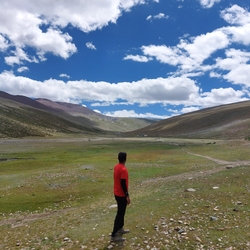Are you figuring out how to beat the summer heat or you are looking for a personal connection with nature away from the chaos of crowded cities?
Either way, kayaking is the perfect solution for you to unlock freedom, thrill, and be one with the magical flow of nature. But, before you learn how to kayak, it is essential to get your basics right. The first step is to know your kayak like you know your body. We say this because, when you slip into the wild waters, the kayak is an extension of your body. Getting your basics right will help you get comfortable with your kayak and prepare you for all the action that lies ahead. In this article, we take you through the different types of kayaks, their different parts, and the functions each of those parts serve.
Types:
Kayaks are built in different styles and are of different sizes. Which serves you best will depend on your purpose and on the nature of the water you decide to use it in. However, when it comes to their features, most of them are alike. Let’s take a quick look at some types of kayaks below:
1) Sit-in-kayaks and sit-on-top-kayaks
Sit-in-kayaks
As the name suggests, in sit-in-kayaks you sit in the kayak where your lower body is completely covered. They come with a skirt that seals the lid to keep the water from entering into the kayak. They are primarily used in cold waters so as to keep your legs warm and dry. The best part about sit-in-kayaks is the balance. When the legs are locked, they create an excellent centre making it easier to manoeuvre your kayak even in harsh waters. The features of this kayak make it easy to go faster and drastically reduce the chances of your kayak flipping over. The downside of this kayak, however, is the draining process. You have to manually pull the plug to drain the water out.

Sit-on-top-kayaks
The sit-on-top-kayaks are easier than the sit-in-kayaks. They are simpler and allow for easy access. There are no skirts making it easier and quicker to get in and out of them. These types of kayaks are mainly used in warm waters. If you're going for a quick swim in still waters or going out into the waters to stretch your legs and relax, sit-on-top-kayaks are ideal. Compared to sit-in-kayaks, water accumulation is not a problem in these ones. They come with drain holes that let the water seep out into the river without you manually having to empty your kayak. There is a downside to this design too, however. Their open model does not keep you safe from getting wet! If bad weather strikes at any point, it might get hard to balance this kayak with all the turbulence in the water.

2) Recreational kayaks
Recreational kayaks are specially made for peaceful waters. They are wider, lighter, and easier to manoeuvre. These are built for some light fun like gliding on small lakes and calm streams. However, they are not the most effective when you have to go against the currents – they aren’t the sturdiest kayaks to handle that sort of pressure from the water. It is hence not advisable to bring them into rough waters.

3) Sea kayaks
Sea kayaks have narrow bodies and pointed ends. Their sharp ends are made to pierce through tall waves and maintain a straight line while paddling. Since they are easy to handle and have extra storage room, kayakers commonly use them for long journeys and expeditions into the sea.

4) Fishing kayaks
Fishing kayaks are from the cold regions of the Arctic. The natives from the Arctic region stitched the skins of dead animals together and ventured into lakes and coastal waters outside the islands for the purposes of hunting and fishing. This activity evolved over the years and has become a renowned sport in the modern world now. In terms of design, fishing kayaks are more spacious and durable than other kayaks, and have enough room for a person to stand up and fish on both salt and freshwaters. Contemporary fishing kayaks come with paddles and pedals, enabling more comfort for the fishers.

5) Crossover kayaks
Crossover kayaks, ace of all waters, are distinctly made to perform under different conditions and to be used for varied purposes. Frequent kayakers very rarely would stick to one terrain or one source of water. It’s likely that throughout the year they venture into many types of waters for different kinds of activities like expeditions on the sea, fishing in the backwaters, or exploring white water rivers. It gets expensive and tedious to rent different kayaks for each occasion. That’s where a crossover kayak comes in - it is the best option available for all kinds of waters and makes taking up different activities an affordable affair. But, the versatility of this variant which is its strength, is also its weakness. Crossover kayaks are not durable enough and not fit enough to handle heavy rapids, strong currents, and waves. They work fine for lesser rapids and gentler waves.

6) White water kayaks
There are four types of white water kayaks:
1. River runners
2. Creek boats
3. Play boats
4. Longboats
River Runners
River runner kayaks are known as the sprinters of the white water world. They are made to surf through long wild rivers and experience different types of rapids.
The term ‘river run’ means a brief journey through whiter water rivers. Kayakers use this variant on white water to practice techniques like rolling and turning. It is also a safe model for beginners to get started with the basics of kayaking.

Creek Boats
Creekers or creek boat kayaks are a model designed to navigate narrower waters. They are built with a high volume base that allows the kayak to resurface quickly when dipped into the water. They are highly stable on sudden rapids, waterfalls, and technical turns.

Play Boats
Play boat kayaks are the shortest of all white water kayaks. They are made for pro-kayakers to perform flips, spins, and stunts on heavy waters. These are the kind of kayaks you’ll see in international competitions and festivals.

Longboats
Longboats are the longer versions of river runner kayaks. They have extra speed and more control. Pro-kayakers mainly use them to cover long distances or participate in white water kayaking races.

7) Inflatable kayaks
Inflatable kayaks are fancy variants devised for children and beginners who prefer convenience. They are helpful on calm waters and low-grade currents. The modern models can be carried as backpacks and filled with electric pumps. Though they have tough skin, the patchwork won't hold for a long time if a sharp rock punctures it. That's why kayakers and tourists mostly use these in still waters.

8) Tandem Kayaks
Tandem kayaks are unique 2-seater kayaks designed to be extra safe and sturdy. They are heavy, and getting them into water is an arduous task. But, they are ideal for children or beginners to travel with experts. They were initially designed for instructors to take care of freshers who panic underwater.

Parts of a kayak:
Be it hiking, biking, or kayaking, knowing the names of your equipment and all their functions helps perform better.
1) Bow
The bow is the front end of the kayak. Not just in kayaks, but every front end of a boat is called a bow. It always represents the direction of your travel. The function of the bow is to pierce through heavy waves and splashes.
2) Stern
The stern is the back end of the kayak. It's slightly smaller than the bow to maintain stability.
3) Cockpit
Like an airplane, a cockpit is where you sit and steer the kayak. It is the biggest hollow space you see on a kayak.
4) Handles
There are two handles in a kayak. One on the bow and the other one on the stern. If you are on the shore, you can drag your kayak out of the water by holding the stern. A rescuer always ties a safety rope on the handle to retrieve the fallen kayak.
5) The Deck
A deck is the whole upper part of the kayak that faces the sky. The shape and size of the deck vary according to the kayak.
6) Hull
The entire bottom section of the kayak that touches the water is known as the hull.
7) Seat
The seat is one of the most integral parts of the kayak. It must be comfortable for your back and help you maintain the correct body posture to paddle with ease. There will be levers to adjust the size of the seat according to your convenience.
8) Footrests
The footrest is the spot where you rest the bottom part of your foot. It can be adjusted according to your height and convenience. If there is a gap between your legs and the footrest, it will be difficult for you to move in a straight line.
9) Knee braces
After the footrest, the knee braces are the second most important part that maintains the balance of the kayak. Once you place your knee under the braces, the kayak will fit appropriately with your lower body.
10) Drain plug
The drain plug is located in the upper part of the stern. If a sit-in-kayak is filled with water, it is taken to the shore. After that, the drain plug is removed & the kayak is placed in a vertical position to flush out all the water stored inside the deck. Don't forget to put the pin on before getting into the water!
11) Paddle
The paddle of a kayak is a straightforward tool with two blades connected to a shaft. It is used to slice through the water surface and steer the kayak in the desired direction.



That's all the basics you have to know before you jump into the water. Since you know your kayaks, their functions and their parts, you are now water-ready! We hope that this guide gives you the confidence to learn better.
Happy Kayaking!






